Have you ever wondered how Google gives you precise and accurate information within a short time whenever you search for something? Well, there are few methods you can use to organize and optimize your website content so that Google knows what to feature on SERPS.
Structured data markups can help you organize your sites to increase visibility to existing and potential clients. As a result, your click-through-rate increases since searches want to consume more of your content. Additionally, it helps users to find your page much faster. To learn more about what structured data markup entails and how to deploy structured data on your website for better SEO, please continue reading.
What is structured data Markup?
Structured data is a website code, usually in a unique semantic format. You utilize it on your website to help various search engines better understand the content on your page. It helps to deliver your message to the right target market, using appropriate presentational features. Here is an example of what structured data markup might look like to the searcher:

How Structured data Works
Search engines work hard to comprehend the content of your webpages. You can provide essential clues to Google using structured data about a page’s meaning to ease the process. For example, if you deal with recipes, you can have structured data presented on your page. Therefore, you are likely to appear in a visual search since people can look for your recipe by cook time, ingredients, calorie count, and more.
Note that you should avoid creating empty pages or even adding data that is not visible to the users. Therefore, the two main things you need to ensure you convey the right information are vocabulary and syntax. For the former, the universally accepted standard in structured data is Schema.org. It’s open-sourced, flexible, and continuously upgraded to suit digital advancements and has enjoyed sponsorship from Google, Yahoo, Yandex, and Bing. Other types include DCMI and FOAF.
On the other hand, search engines support three types of syntax formats as outlined below;
Javascript Objective Notation for Linked Data (JSON-LD)
It is a structured data schema for marking up your site. It has the support of most search engines such as Yandex, Yahoo, Google, and Yahoo. Besides, in 2015, Google announced that JSON-LD was the preferred format.
While using it, you don’t have to input it on a page; instead, you embed it in a script tag. Further, you don’t have to alter HTML elements since it’s not placed inline. Here is an example:

(Image Credit: Moz)
Microdata
Microdata is a set of tags that you can add directly to the HTML to mark up your page. Each section consists of , s, and . For instance:
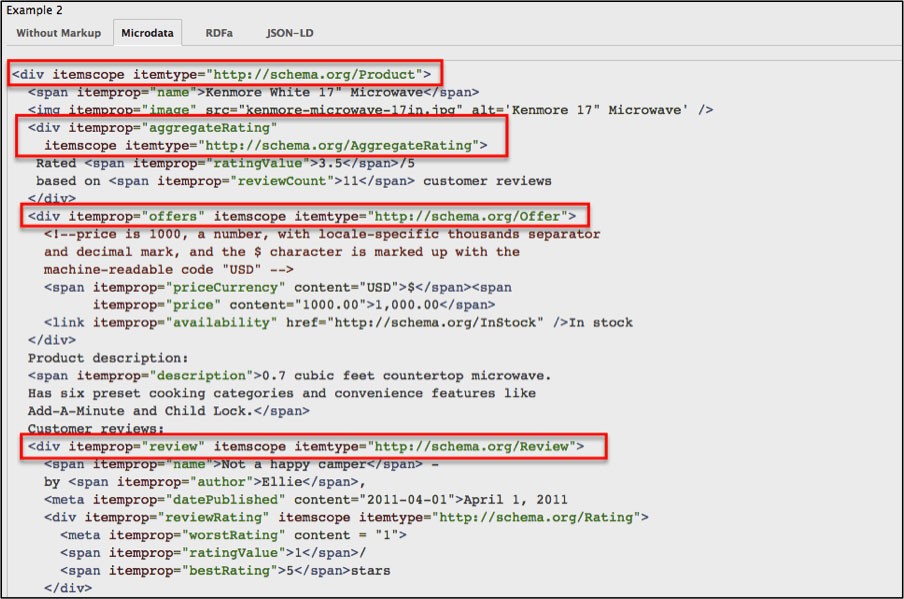
(Image Credit: Search Engine Journal)
RDFa
You can use the Resource Description Framework in attributes (RDFa) as a google markup metadata within your webpages.
Common Structured data Markup Types for SEO
Adding Google structured data types in your page allows search engines to use your site information to enhance SEO. Below are a few common schema markups that you can utilize.
You Might Also Like
Local Business Markup
Local business schema helps boost your Google my business listing for your venture or organization. Therefore, search engines can know your company name, phone number, address, operational hours, image, etc. For example:
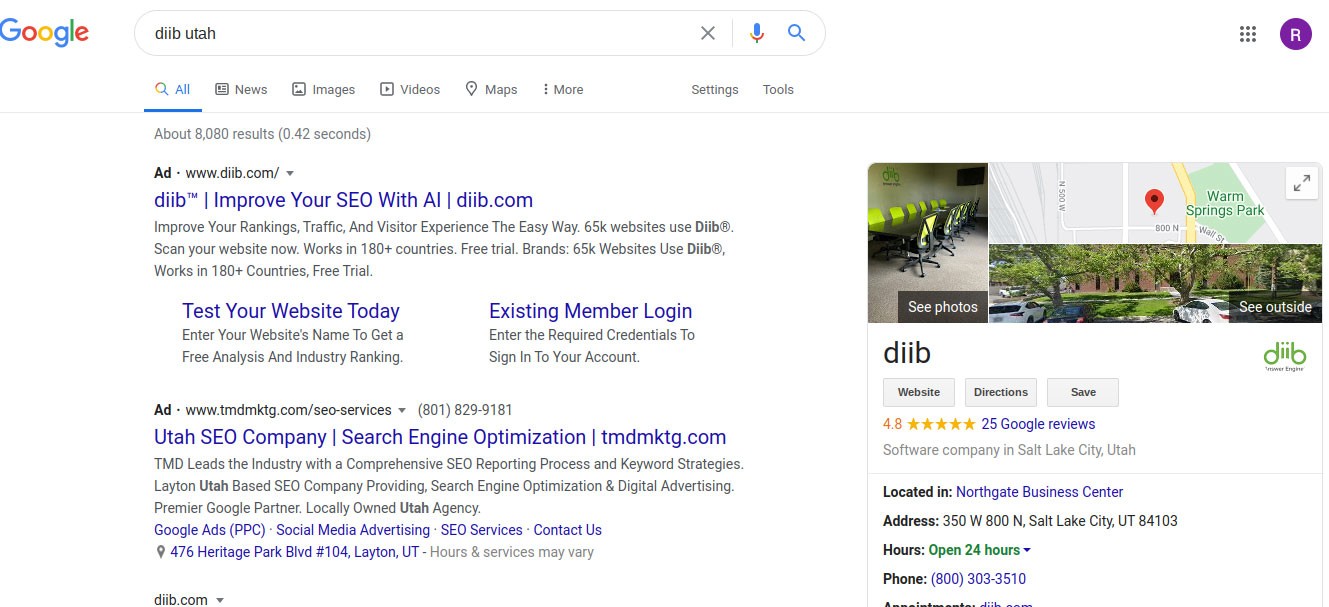
Breadcrumbs Markup
Breadcrumbs indicate the specific category or web location of your page on a search engine result. It’s on a small text path at the top of a page, showing where the user is on a site. It also helps in reducing bounce rates.

Video Markup
Video schema markup helps Google to crawl and index the videos on your page. Therefore, your clips will appear on Google video search beside those from YouTube.
Recipe Schema Markup
If you have a recipe website, this markup will help your pages to appear as a rich snippet. Additionally, your searchers can evaluate your products before clicking on a link.
Review Schema Markup
Reviews are one of the major factors that customers consider before purchasing your products or services. Using this markup helps generate your best attention-grabbing testimonials directly in the SERP pages. Further, your target market clients will have an easy time getting useful information without doing massive searches.
Article Markup
If you publish blogs or news posts, scheme article markup is a useful resource for SEO. It makes search engine tasks easier in understanding the time you published the content, the headline, a featured image, or even a video. Further, depending on the kind of posts you write, different types of article markups are chosen.
Product and Offer Markup
You can use the product and offer markup to sell a specific item on your site since they facilitate the delivery of information such as price. Therefore, your products will stand out among other competitors in the same industry. It also lets clients make a comparison of what you sell with a similar item from a different supplier.

Person Market Markup
The person market schema gives information about your identities, such as the name, address, education, family members, and birthday. It helps searchers get your data without digging deeper since Google assumes users looking for a name want some necessary details.
Organization Markup
Using organization markup clarifies your organization’s introduction, such as the contact info, social profiles, official logo, and location. It helps searchers to have all the necessary information about your company within a few clicks. Besides, your target customers can quickly get your contacts.
Job Posting Schema
The job posting markup enhances your listing appearances in search outcomes to ensure the right candidates find your site. Therefore, you can easily share essential information on your sites, such as the position’s details and logo.
Test your SEO in 60 seconds!
Diib is one of the best SEO tools in the world. Diib uses the power of big data to help you quickly and easily increase your traffic and rankings. We’ll even let you know if you already deserve to rank higher for certain keywords.
- Easy-to-use automated SEO tool
- Keyword and backlink monitoring + ideas
- Speed, security, + Core Vitals tracking
- Intelligently suggests ideas to improve SEO
- Over 500,000k global members
- Built-in benchmarking and competitor analysis
Used by over 500k companies and organizations:
Syncs with 
Event Schema
The event schema markup helps you to provide important information on a specific occurrence. Therefore, you can update details on the location, ticket sellers, date, and time that would help you appear on top of search results and Google maps.
How to Implement Structured Data Markup on your Website
You can use two ways to implement Google markup on your website. If you are tech-savvy or a web developer, you can utilize your skills manually and add them to your web content. The process involves editing your webpage source code to create a structured data schema. However, as much as this procedure may give you control over your schema markups, it may not be the most efficient solution.
It would be best to utilize the Google detailed process to have the best result on various content types. In case you don’t have much web development techniques, please use the markup tool to assist you in completing the coding tasks.
For instance, you can use Structured Data Markup Helper, a Google web-based tool.
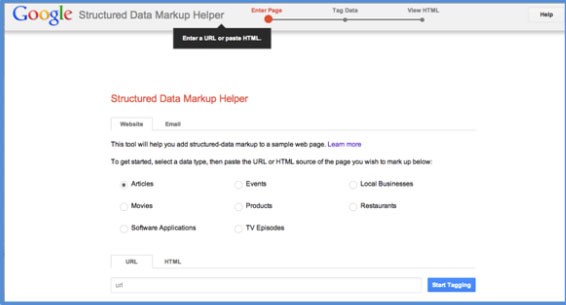
Hence, the instrument will assist in generating markups relating to items such as;
- Events
- Movies
- Articles
- Job postings
- Book reviews
- Datasets
- Tv episodes
- Local businesses
- Restaurants
- Software applications
- Question and answer pages
Below is a detailed process of how you can use it;
Choose your Preferred Schema
First, it’s essential to choose the types of schema you intend to use on your website. Keep in mind that your choice has to fit with the general theme of your page. Also, note that you should choose a schema type with a high chance of appearing naturally for your queries.
Therefore, visit Schem.org for the available markups and start with the common ones. It would be wise to also consult with Google structured data types to help you get the ones used in rich snippets.
Organize your Workflow
You can set up a system to help you keep track of the markups you have selected. It may seem like a less crucial step, but it enables you to organize your work. You can do it using an excel sheet where you list all the pages that need a markup and align them to the schema required.
It would be wise to put more emphasis on the pages that have more resourceful information, which can include those of top-selling items like high-converting guides. Moreover, choose the technique that best suits your venture’s overall objectives. It may be challenging to find the pages in some cases, but Google Analytics can assist you in making the selection on your behalf. It helps you view the pages with the highest conversions, traffic, and more.
Launch the Markup tool
You will find many free markup tools for your needs, but Structured Data Markup Helper is ideal. It’s pretty straightforward and guides you through the entire procedure. The next step is to choose the most appropriate schema and then enter a URL from the excel sheet you created.
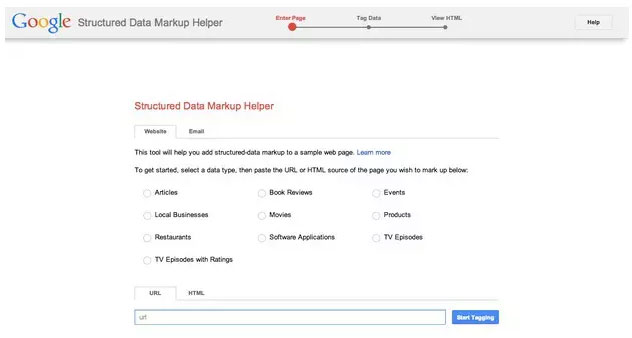
Create a Structured Schema
Proceed to highlight the appropriate page elements and assign tags as well as add any missing ones. You can make additional tags by clicking on the ‘Add missing tags button’ on the bottom right. As a result, the tool will open a menu to add more elements manually, such as description, name, rating, etc.
For instance, when using the product markup, highlight the price from the dropdown section. The set up makes it convenient for your organization to design structured data for SEO purposes.
Next, tap on ‘Create HTML’ for the tool to provide the structured data code on the top right. Still, if any information is left out, click on ‘back to tagging’ to allow you to complete marking up your page. Please remember that JSON-LD is the recommended format over Microdata by Google; thus, it’s advisable to use it continually. Besides, organizations that use it have achieved better outcomes on SEO. The last step should be to paste the code into the respective page’s body or head tags on your site.
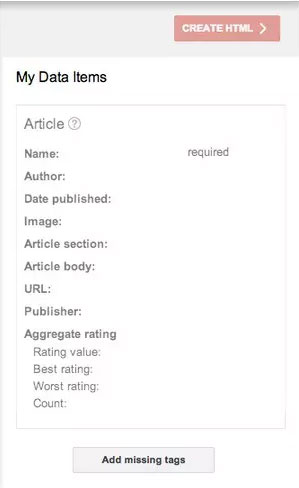
Test the Data Markup
Despite Google generating your structured schema, it would be wise to test it. It will help you fix any errors, such as typo, that you may not have noticed when making additional tags manually. You can use Google’s structured data markup testing tool to make thorough scrutiny.
Alternatively, you can opt for Rich Results Testing, especially when using structured data to create a rich snippet. It lets you preview the outcome of your page in the search engines.
You can then proceed to the markup from the tool and paste it on the ‘code’ section and hit the ‘Test code’ button. You will view all the information about any warnings and errors in your data and possible ways of fixing them.

Update your page with the Structured Markup
After successfully designing and testing your structured markup data, it’s time to include it on the webpage. The process involved maybe a little bit technical thus, you may need developer skills, especially when dealing with HTML.
However, if you know how to modify pages, go to the structured data markup testing tool, and copy the generated code. Next, paste it before the closing tag, which is mostly at the webpage’s end.
Monitor Results on Google Search Console
Whenever you have well-structured data, you most likely want to generate rich snippets. Therefore, it’s essential to monitor your data markups’ appearance and performance in Google’s Search Console to help you view the created pages, and the clicks earned.
On the tool, go to ‘search results’ underperformance and tap on the ‘search appearance’ button. Another option is to utilize the tool’s filters so that you can view rich snippets’ performance by date, country, device, page, among many. Monitoring your snippet’s performance gives you essential insights on how your structured markup helps your company get more clicks and views. Additionally, you will get a clear picture of each page’s traffic, conversions, and rankings.
Why you Should use Schema on your Website
Structured data is increasingly becoming an integral part of search engines as people work on driving traffic to their pages. Here are some essential reasons why you should utilize various structured data markup types on your site.
Improved Search Results
The primary motive of using schema markups is to enhance traffic to your web pages. Proper utilization of structured data will make your content eligible for a featured snippet position at SERP’s peak. Besides, if you want your venture to grow online, you must have an excellent ranking.
Increase Dwell time
Google checks on dwell time to see how long searchers stay on your page before going back to SERPs. In some cases, users can click on a link then return to the initial search outcomes almost immediately after realizing they have not found the answer they wanted.
However, when using structured data, it ensures that your searchers’ get the information they expect. Therefore, it helps to reaffirm their decision to tap on your webpage continually. Once they have more confidence in your content, more users will spend more time on your website and visit the page later.
For instance, if you have an e-commerce website, a customer may bounce among multiple pages while looking for a specific product. The worst-case will happen if the item is out of stock, yet the client does not know when you will restock. You, therefore, need to utilize product markup to inform users beforehand if the item is available to lure them into your page.
We hope that you found this article useful.
If you want to know more interesting about your site health, get personal recommendations and alerts, scan your website by Diib. It only takes 60 seconds.
Entity Association
When you describe certain page elements on your site using data markup, you create essential entities. As a result, it boosts your website relevance for various types of searches. For instance, when using local business markups, you can use the tags to describe your organization’s zip code, phone number, and address to help establish your page in a specific location. Therefore, when searchers enter a locally oriented query, there is a higher chance that your venture will appear among the top results.
Enhance Click-through Rates (CTRs)
Using some types of structured data may result in a rich snippet in Google search results. As a result, it boosts your visibility, which drives users to your page. The more clicks your site gets when searchers view your content, it helps your site attain a better CTR level.
It is a crucial metric; thus, it sends a prompt to search engines that your site has more relevance to users. Therefore, search engines respond by moving your page higher on rankings, which helps gather more traffic. Here is an example of the different ways the schema can look to the searcher:

Diib®: Custom Metrics for All Structured Data Markup
Google and other search engines are continually making enhanced changes and improvements in how they present and aggregate information. To achieve better results for your company website, you need to let your schema work for you. With Diib’s User Dashboard, customized alerts and objectives can give you deep insights into the effectiveness of your structured data markup campaign and actionable steps for improvement. Here are some of the features you’ll love about the Diib platform:
- Monitoring of Google’s Core Algorithm and schema changes/updates
- Auditing of your structured data markup regularly
- Notifications of broken pages where you have backlinks (404 checker)
- Vital keyword, backlink, and indexing monitoring and tracking tools
- Provide competitor analysis
Diib offers a free 60 second website scan that can help you with your website ranking issues or simply call 800-303-3510 to speak with a growth expert to learn more.
FAQ’s
Structured data markup is a regulated and standard format for laying out the structure of a webpage. It helps search engines, like Google, to know what to find on your page and direct searchers where to find information they seek.
Examples for this kind of data are: numbers, dates, groups of words and numbers called strings, credit card numbers, stock information, geolocation, and more.
Structured data is composed of the data listed in the answer above. Unstructured data is everything else, meaning, data that isn’t simple to search. This could be audio, video or even social media posts.
The short answer is yes, it can help SEO. It helps search engines to figure out your website and improve your relevancy signal. Studies have also shown that structured data, and snippets specifically, also help to improve the CTR of webpages; indirectly contributing to ranking.
Semi-structured data have different attributes but are included in the same class. Examples of semi-structured data include: XML and other markup languages, emails.



